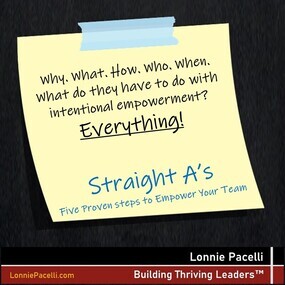Lonnie Pacelli's Blog, page 6
December 21, 2024
Free 12/24-25: 17 Tips to Help You Find True Work Life Balance
[image error] Free 12/24-25: 17 Tips to Help You Find True Work Life Balance
Get it at https://amzn.to/2DQiKOI
#freebook #worklifebalance #leadership #kindle #kindlefire #ebooks #ebook #Kindlefreebooks #Kindledeals #FREE #mustread #goodreads #greatreads #freebie #freebies #kindlebook #ad
Get it at https://amzn.to/2DQiKOI
#freebook #worklifebalance #leadership #kindle #kindlefire #ebooks #ebook #Kindlefreebooks #Kindledeals #FREE #mustread #goodreads #greatreads #freebie #freebies #kindlebook #ad
Published on December 21, 2024 02:28
December 14, 2024
The Downside of 'Tough it Out'
 Recently I read a Forbes article about navigating leadership challenges in a rapidly changing world. The article highlighted 10 areas of focus for survival.
Recently I read a Forbes article about navigating leadership challenges in a rapidly changing world. The article highlighted 10 areas of focus for survival.Nothing on the list was an earth-shattering surprise for me. Things like building a robust network, cultivating emotional intelligence, and embracing continuous learning can be found on most lists of focus areas for leaders. What I found interesting was what the article listed as number one: Prioritize mental and physical health.
For some, this might not make much of an impression. For me, it brought back a trajectory-changing time in my life that happened more than 30 years ago.
Read more at ProjectManagement.com.
Published on December 14, 2024 02:37
December 6, 2024
4 Tips for Pragmatic Customer Centricity
 Recently, Harvard Business Review published an article about what the next generation of project management will look like. The article highlighted 10 next-generation skills:Organizational awarenessData acumenCross-functional collaborationDecision-makingWillingness to explore and adopt new technologyFinancial acumenProcess and framework expertise (i.e., business process improvement, agile, organizational change management, risk)Growth mindsetThe ability to coach and motivate teamsCustomer centricity Now, these are all good skills for today’s project manager to focus on to be relevant tomorrow. There is one item on the list that piqued my interest the most.
Recently, Harvard Business Review published an article about what the next generation of project management will look like. The article highlighted 10 next-generation skills:Organizational awarenessData acumenCross-functional collaborationDecision-makingWillingness to explore and adopt new technologyFinancial acumenProcess and framework expertise (i.e., business process improvement, agile, organizational change management, risk)Growth mindsetThe ability to coach and motivate teamsCustomer centricity Now, these are all good skills for today’s project manager to focus on to be relevant tomorrow. There is one item on the list that piqued my interest the most.Read More at ProjectManagement.com .
Published on December 06, 2024 02:30
November 29, 2024
Right-Size Passion: Cultivate it, Don't Squelch It
 Some years back one of my sales directors had been diligently working with online retailers to partner to get our retail product on their websites. During a one week period she had several very promising phone calls which in turn generated lots of excitement on her part. The term exuberant couldn't quite capture how she was truly feeling. She was absolutely giddy with excitement. More importantly, she landed several very profitable accounts. Love it!
Some years back one of my sales directors had been diligently working with online retailers to partner to get our retail product on their websites. During a one week period she had several very promising phone calls which in turn generated lots of excitement on her part. The term exuberant couldn't quite capture how she was truly feeling. She was absolutely giddy with excitement. More importantly, she landed several very profitable accounts. Love it!This situation reminded me about the importance of cultivating passion. Lots of times an individual or a team can get so taken up with small victories that good sound business logic can take a back seat to passion. As a leader, it is important that you direct and channel the passion in your team to ensure that your business objectives can still be met. Let passion run amok and you run the risk of poor decisions being made; squelch passion, and you're likely to sap the energy from your team and not achieve the best possible results.
Be a voice of reason with your team but do so in an encouraging and positive manner. Squelch passion and you'll squelch results.
Lonnie Pacelli
Keynote Speaker | Board Director | Autism Advocate | Author | Project Management Expert | Microsoft/Accenture Veteran
See his books on Amazon.
Published on November 29, 2024 02:26
November 22, 2024
Free 11/26-27: 17 Tips for Better Team Building Offsites
 Free 11/26-27: 17 Tips for Better Team Building Offsites
Free 11/26-27: 17 Tips for Better Team Building OffsitesGet it at https://amzn.to/2FwzKeM
#freebook #teamwork #leadership #kindle #kindlefire #ebooks #ebook #Kindlefreebooks #Kindledeals #FREE #mustread #goodreads #greatreads #freebie #freebies #kindlebook #ad
Published on November 22, 2024 02:33
Are You a Chronic Canceler?
 Years back, I worked on a large, high-visibility program. My direct boss was generally well respected by senior leadership for his client management abilities and how well he communicated upward. He scheduled a weekly two-hour staff meeting with his direct reports.
Years back, I worked on a large, high-visibility program. My direct boss was generally well respected by senior leadership for his client management abilities and how well he communicated upward. He scheduled a weekly two-hour staff meeting with his direct reports.Most times, my peers and I would sit in the meeting waiting for our boss to show up, with him either coming in more than an hour late or not at all. There was always some excuse as to why he couldn’t meet. We had a running joke about what time our boss would show. It was frustrating that we seemed to not matter much to him, particularly on such a high-visibility program.
This behavior was in direct contrast to our boss’s boss, the executive in charge of the entire program. If he made time for you to meet with him, he kept it. If you were late or didn’t show, he let you know about it. In the rare event that he did need to cancel, his assistant would contact you with not just a cancellation but alternate times that he was able to meet. He treated both his and others’ time with respect.
The experiences with my direct and skip-level bosses left a very significant impression on me. Both worked on the same program, yet the one who had the greater span of control also had a much better command of his calendar and demonstrated more respect for others than my direct boss did. Seeing how the two worked together showed me what I did not want to be known as:
Read more at ProjectManagement.com.
Published on November 22, 2024 02:33
November 16, 2024
Making Career Lemonade from Project Issue Lemons
 For the past year, I have been coaching a high-potential leader. Over the past few months, we have been talking about the concept of a pro forma resume. This is a resume you would like to have in the future, which allows you to chart your career movement and experiences to make the pro forma resume a reality.
For the past year, I have been coaching a high-potential leader. Over the past few months, we have been talking about the concept of a pro forma resume. This is a resume you would like to have in the future, which allows you to chart your career movement and experiences to make the pro forma resume a reality.In this leader’s case, we have been talking about what he wants his resume to look like in 10 years. His pro forma has given him a north star to strive for in his career and is providing a roadmap to help him get there. In a recent meeting, he brought up a benefit of the pro forma that I hadn’t considered, but one that makes perfect sense.
He is currently leading a particularly complex project involving both employees and volunteers, and has exposure at the very highest levels of the organization. The work is particularly stressful, and he is facing a number of new challenges.
In our meeting, he was feeling a bit overwhelmed and stressed due to the project and its issues. As we talked about the project, he made an interesting observation. “You know,” he said, “there are a lot of tough things I’m working through, but knowing I can include some of these things on my resume is really going to enhance my marketability.”
His comment caught me off guard, not because it was in any way wrong (in fact it was a brilliant observation), but because I had never articulated like he did the link between navigating thorny issues and how they enhance a resume. He later told me that the idea of having a more robust resume as result of the project and its challenges energizes him to address the issues head on.
Now that’s a “making lemonade out of lemons” perspective.
Read more at ProjectManagement.com.
Published on November 16, 2024 02:35
November 8, 2024
The Clarity PM: 6 Areas to Improve
 One of my favorite movies is A Few Good Men. The riveting court scene at the end of the movie where Lt. Daniel Kaffee (played by Tom Cruise) is questioning Col. Nathan R. Jessep (played by Jack Nicholson) ranks right up there with some of my favorite movie scenes. “You can’t handle the truth!” and “Did you order the code red?” are lines that could be said in just about any venue or context, and someone will likely tie the line to the movie.
One of my favorite movies is A Few Good Men. The riveting court scene at the end of the movie where Lt. Daniel Kaffee (played by Tom Cruise) is questioning Col. Nathan R. Jessep (played by Jack Nicholson) ranks right up there with some of my favorite movie scenes. “You can’t handle the truth!” and “Did you order the code red?” are lines that could be said in just about any venue or context, and someone will likely tie the line to the movie.In another scene, Jessep is explaining to Kaffee that, “We follow orders or people die, it’s that simple. Are we clear?” Jessep then underscores, “Are we clear?” to which Kaffee responds, “Crystal.” The scene intensifies in its back-and-forth dialogue until Jessep…actually I won’t spoil it for anyone who hasn’t seen the movie.
The ”Are we clear”? line has stuck with me over the years. Aside from it being powerful theatrics, it’s something that I believe is a foundational tenet of what we as PMs are all about.
Read more at ProjectManagement.com.
Published on November 08, 2024 02:32
November 1, 2024
I'll Be Done Friday, Honest! Six Techniques to Ensure Solid Project Management Execution
 Some time back I was responsible for a portfolio of projects being done within the finance organization of my company. One of the projects was outsourced to a large consulting firm who supplied the project management, analysis, and development resources to the project. I would hold weekly meetings with the project manager who consistently gave me a "thumbs up" on the project up to the first key milestone being hit. When the week of the first milestone approached, he announced that the milestone was going to have to slip by a week to ensure successful delivery. The next week came along and again the project slipped a week. This went on for two more weeks with the promise of "we'll for sure nail it next week." I decided to do some crawling around the project to assess where the project was really at. Turns out we were at least a month away from delivering to the milestone which was already a month late.
Some time back I was responsible for a portfolio of projects being done within the finance organization of my company. One of the projects was outsourced to a large consulting firm who supplied the project management, analysis, and development resources to the project. I would hold weekly meetings with the project manager who consistently gave me a "thumbs up" on the project up to the first key milestone being hit. When the week of the first milestone approached, he announced that the milestone was going to have to slip by a week to ensure successful delivery. The next week came along and again the project slipped a week. This went on for two more weeks with the promise of "we'll for sure nail it next week." I decided to do some crawling around the project to assess where the project was really at. Turns out we were at least a month away from delivering to the milestone which was already a month late.Needless to say I was less than thrilled with the consulting firm running the project. They sent out one of their heavyweight project managers to assess the situation. After two hours of reviewing the project he reported back to me that the project had slipped, not due to anything his organization had or hadn't done, but because of things we as the client did to cause the problems. Needless to say I pretty much lost it with him. I then went through the project plan with him and went through each task and peppered him with questions about why his project manager hadn't managed the execution of the project and why we were continuing to get a 'thumbs up" when in fact the project had slipped horribly. After my inquisition he said he'd follow up and get back to me. I'm still waiting. Ah, the best laid plans of mice and men often go awry. Despite how pretty a project schedule looks, how clear the organization chart is, or how well articulated the risks and issues are, the most successful projects execute great to a great plan. Solid project management execution means driving the plan, making adjustments as necessary to address unforeseen issues (if you are able to run projects that never have issues email me at lonnie@leadingonedge.com; I'd like to spend a day in your world), and removing roadblocks which can inhibit successful completion. The project manager has to stay steady at the helm making sure these things happen; they won't just happen by themselves. To articulate this a bit more here are three formulas for you to keep in mind:
Planning + Execution = Project Success
Execution - Planning = Randomized Flailing
Planning - Execution = Well-Dressed Inertia
Through my experience I've come up with six techniques that can help you as a project manager better ensure project success. While this isn't an exhaustive list of everything you can do, it does highlight some specific areas which can help keep a project from derailing: Snuff out and squash "shiny objects" - First, let's put shiny objects in context; to me a shiny object isn’t important to the task at hand and isn’t time-sensitive. If something comes across your desk that can be done later without impact to your work, yet interrupts what you’re doing, then this in my view constitutes a shiny object. It’s also important to distinguish between shiny objects and the garden-variety fire-drill. The primary difference to me is a fire drill needs to be done immediately, otherwise there is some material and tangible business consequence; whereas with a shiny object there is no material and tangible business consequence if it doesn’t get done. This is an important distinguishing factor because many shiny object violators I know view their shiny objects as fire drills and take comfort in responding to fire drills because of the sense of accomplishment they feel in putting out the fire. Be on the lookout for shiny objects and squash them before your team gets derailed.
Watch the "off-workplan" tasks - Recently I worked with a project team that had a pretty decent project plan with dependencies, resources, and timeframes all laid out. The problem, though, was that the project plan assumed 100% resource focus but only about 60% of the resource focus was dedicated to the project plan. The other 40% was consumed via to-do lists which the project manager kept in addition to the project plan. Thus, the project was doomed to a 40% schedule slip right from the get-go because of the to-do list tasks. As the project manager, you have the responsibility of ensuring that all project-related activity is reflected in your project plan and that you specifically articulate the percentage of time resources are dedicated to tasks.
Think realistically aggressive when developing estimates - I've worked with three distinct personality types when it comes to estimating levels of effort. The first personality type is Ms. Reality. She looks at a given set of tasks and develops a realistic yet aggressive expectation of what will be required of her to complete the task. More importantly, she hits her dates with a high degree of reliability. The second personality type is Mr. Op T. Mystic. Mr. Op consistently under-estimates tasks and provides a "if all of the stars align" projection on completing tasks. Tasks quickly get to 90% done then stay there forever. The third personality type is Mr. Gloom N. Doom. Mr. Gloom typically provides worst-case estimates and will slather on contingency like barbecue sauce on ribs. The secret sauce (can you tell I really like ribs?) here is to recognize the personality type you work with and try to snuff out reality with each personality type. Sure, you'll get some push-back particularly from Mr. Gloom, but unless you apply some aggressive reality to your estimates you're going to have a hard time getting sponsors and higher-ups to view you as a credible project manager.
Hold weekly status meetings - I am a big fan of weekly status meetings and weekly status reports, particularly on high-visibility projects. In fact, I have become a strong proponent of creating my project status report (see my status report template at the bottom of this article) right in my status meeting. Key to this is focusing on project plan tasks, milestones, risks and issues during the status meeting. I've been through way too many status meetings where the focus was on each team member talking about accomplishments and effort versus results. Now, it's nice that all of the team members are working so hard, but when everyone starts patting themselves on the back for how many hours are being worked at the expense of managing to schedule, you've got a sick project on your hands. Keep the status meetings focused on schedule, risks and issues and keep them very regular. Don't let weeks go by without doing them unless you're willing to play Russian Roulette with your schedule.
Expose the violators - So okay, before I have every HR manager ready to shoot me let me explain what I mean. In status meetings, I think it is completely within bounds for a project manager to expect project team members who don't deliver on their commitments to explain to the project team why they aren't pulling their weight. Too many times I've seen project managers shield slacker project team members or not force them to explain their actions (or inaction as the case may be). What each member of the project team needs to recognize is when he or she doesn't perform it isn't just the project manager that is being let down; it is the entire team. When each project team member feels accountable to the rest of the team for delivery and directly feels as if he or she is letting the rest of the team down he or she is more likely to perform and meet dates. This can be very effective in getting teams to perform, just make sure it is done with respect. It's about getting teams to perform, not about skewering someone's dignity.Use the 1/1/1 rule when planning tasks - Great execution starts with great planning. Sure, we've all seen acts of heroism where a project team worked 90 hours a week to get a poorly conceived and planned project done on time. However, no one likes to work in that mode. Projects that are well planned are more likely to be delivered on time, per customer expectation, and within budget, period. A key component of good planning is using what I call the "1/1/1" rule in work breakdown structure decomposition which stands for "one deliverable, one person, one week." Driving to this level of detail in a project plan ensures there is no ambiguity on who is responsible for the task and what the deliverable associated with the task needs to be. Also, by using a one week duration you better ensure the task will be completed within one weekly status reporting cycle. Most importantly, you'll minimize surprises of a "90% complete" taking forever for the last 10% to be complete.
Excellent planning coupled with strong execution is crucial to ensuring the success of any project. Subtract planning or execution from a project, and you either get the randomized flailing of a project out of control, or the well-dressed inertia of a good-looking project going nowhere.
Lonnie Pacelli
Keynote Speaker | Board Director | Autism Advocate | Author | Project Management Expert | Microsoft/Accenture Veteran
See his books on Amazon.
Published on November 01, 2024 02:35
October 26, 2024
Free 10/29-30: 16 Tips to Become a Best-in-Class Mentor
 Free 10/29-30: 16 Tips to Become a Best-in-Class Mentor
Free 10/29-30: 16 Tips to Become a Best-in-Class MentorGet it at https://amzn.to/2DPYAET
#freebook #teamwork #leadership #kindle #kindlefire #ebooks #ebook #Kindlefreebooks #Kindledeals #FREE #mustread #goodreads #greatreads #freebie #freebies #kindlebook #ad #mentor
Published on October 26, 2024 02:33



